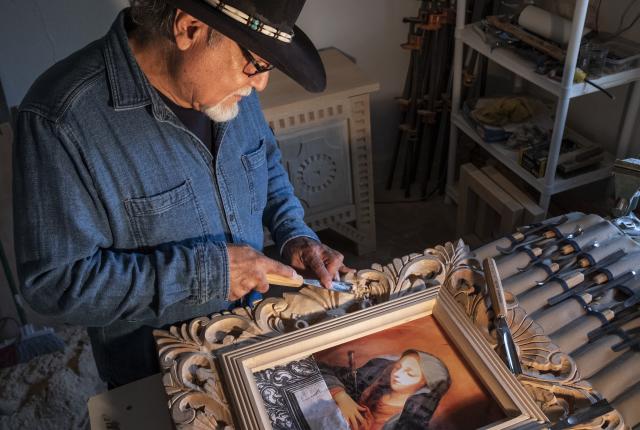Above: Master furniture maker Anthony Martinez crafts traditional, Spanish Colonial pieces from his New Mexico studio. Photograph by Stefan Wachs.
WHEN YOU SEE A COLORFULLY PAINTED trastero or intricately detailed chest made by Anthony E. Martinez, you might think you’re gazing upon a treasured piece from the past. Each item, handcrafted in his Santa Fe studio, is based—with painstaking detail—on authentic Spanish Colonial furniture, a skill he’s refined for more than 40 years.
“What captures my attention in Spanish Colonial furniture is the beauty, the history, and the culture behind it, which I am a part of,” says Martinez, who grew up building forts and clubhouses in the Española and Chimayó valleys. At age eight, he asked his father for a pocketknife, which started him whittling toys, animals, swords, and other items. “I was fascinated by the beauty of wood,” he says.
The hand-carved New Mexican furniture in his grandparents’ house captivated him. “There was one particular piece in the kitchen, a corner cabinet,” he recalls. “It was turquoise, with beautiful carvings painted with various colors.” When trendy new chrome-and-vinyl furniture began to replace hand-carved furniture in the 1950s, the young boy took note.
What captures my attention in Spanish Colonial furniture is the beauty, the history, and the culture behind it, which I am a part of.
Initially, Martinez built coffee tables, chests, and other furniture with a contemporary vibe. He switched styles and devoted himself to the handcrafted furniture he remembered in his grandparents’ home only after Santa Fe’s Traditional Spanish Market accepted him in 1992.
Martinez dug deep into Santa Fe museums noted for their Spanish Colonial furniture collections. “I would go there to research and study the historical pieces,” he says. He applied that same dedication to keeping the heritage alive for future generations. “Through the years, I have mentored youth in furniture making in order to carry on this tradition.”
Martinez spent years experimenting with finishes and developing his own style to create his regal chests, carved with pomegranates, lions, and other Old World motifs, or embellished with cornhusk appliqué rosettes and antique hardware imported from Spain and South Africa.
He’s renowned for making a new piece look old. “When you see an old piece of furniture, it has a certain patina that comes from people rubbing their hands on it over time,” he says. “Patina is the most important part of my process, and it took years of experimenting with different shades of stains to bring out the patina.”
One of his bestselling chip-carved chests—a handsome mahogany-colored pine piece richly carved with geometric motifs—originated in the 18th century with the Valdez family of carpinteros, from the Velarde and Alcalde areas, north of Española.
“I first saw these pieces in the basement of the museums in Santa Fe and fell in love with their beauty,” he says. “As I’m building these chests, it takes me back to the past. I sometimes picture these old craftsmen building their pieces, and what they went through. It’s a lot of work and a lot of detail.
Anthony E. Martinez
505-501-1700


